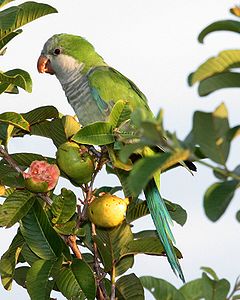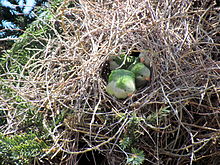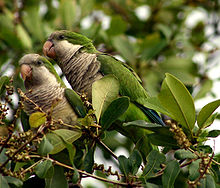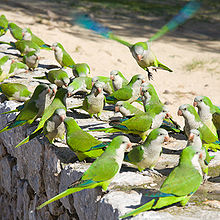- Monk Parakeet
-
Monk Parakeet 
Wild Myiopsitta monachus monachus in Argentina. Conservation status Scientific classification Kingdom: Animalia Phylum: Chordata Class: Aves Order: Psittaciformes Family: Psittacidae Subfamily: Psittacinae (but see text) Tribe: Arini (but see text) Genus: Myiopsitta
Bonaparte, 1854Species: M. monachus Binomial name Myiopsitta monachus
(Boddaert, 1783)Subspecies 2-4, see text
Synonyms Psittacus monachus Boddaert, 1783
Bolborrhynchus luchsi Finsch, 1868
Myiopsitta luchsi (Finsch, 1868)
but see textThe Monk Parakeet, also known as the Quaker Parrot, (Myiopsitta monachus) is a species of parrot, in most treatments the only member of the genus Myiopsitta. It originates from the temperate to subtropical areas of Argentina and the surrounding countries in South America. Self-sustaining feral populations occur in many places, mainly in North America and Europe.
Contents
Description
The nominate subspecies of this parakeet is 29 cm long on average, with a 48 cm wingspan, and weighs 100 g. Females tend to be 10-20% smaller but can only be reliably sexed by DNA blood or feather testing. It has bright green upperparts. The forehead and breast are pale grey with darker scalloping and the rest of the underparts are very-light green to yellow. The remiges are dark blue, and the tail is long and tapering. The bill is orange. The call is a loud and throaty chape(-yee) or quak quaki quak-wi quarr, and screeches skveet.[1]
Domestic breeds in colors other than the natural plumage have been produced. These include birds with white, blue, and yellow in place of green. As such coloration provides less camouflage, feral birds are usually of wild-type coloration.
Systematics and taxonomy
Myiopsitta monachus is presently the only unequivocally accepted member of the genus Myiopsitta. However, it seems that the Cliff Parakeet (see below) will eventually be recognized as a species again, as it has been on-again-off-again since it was first described in 1868.[2] It is presently included with the Monk Parakeet because there is too little up-to-date research on which an authoritative taxonomic decision could be based. The AOU for example has deferred recognizing the Cliff Parakeet as distinct "because of insufficient published data".[3]
Consequently, there are four subspecies presently recognized:[1]
- Myiopsitta monachus monachus (Boddaert, 1783) – Argentina from SE Santiago del Estero Province throughout the Río Salado and lower Paraná basins to Buenos Aires Province and Uruguay
- The largest subspecies
- Myiopsitta monachus calita (Boddaert, 1783) – Andean foothills up to 1,000 m ASL, from SE Bolivia (Santa Cruz and Tarija departments) to Paraguay and NW Argentina, then west of the range of monachus, extending into the lowlands again in Río Negro and possibly Chubut provinces.
- Smaller than monachus, wings more prominently blue, grey of head darker.
- Myiopsitta monachus cotorra (Finsch, 1868) – SW Brazil (Mato Grosso, Mato Grosso do Sul, possibly Rio Grande do Sul[4]) throughout the Río Paraguay and middle Paraná basins as well as the Gran Chaco.
- Essentially identical to calida but reported as less yellow below and brighter overall.
- Cliff Parakeet, Myiopsitta (monachus) luchsi (Boddaert, 1783) – Andean valleys of central Bolivia between 1,000[5]/1,300[2] and 3,000 m ASL, roughly from SE La Paz to N Chuquisaca departments. Essentially the same range as the Red-fronted Macaw.
- Smaller, with clearer plumage pattern: no scalloping on breast, underparts brighter yellow, underwing lighter. Base of maxilla dark.
The first three subspecies' ranges meet in the general area of Paraguay, and there they are insufficiently delimited. The distinctness and delimitation of calita and cotorra especially requires further study. As regards the Cliff Parakeet, it appears as if its altitudinal range does not overlap with that of calita/cotorra and that it is thus entirely – but just barely – allopatric.[5]
Like the other Neotropical parrots, the Monk Parakeet is usually placed in the tribe Arini, which might warrant elevation to subfamily rank as Arinae. M. monachus belongs to the long-tailed clade of these – macaws and conures, essentially –, which would retain the name Arini/Arinae if this polyphyletic group is split.
Ecology and behavior
 Nests in Zaragoza, Spain.
Nests in Zaragoza, Spain.
The Monk Parakeet is globally very common,[6] and even the rather localized Cliff Parakeet is generally common.[2] In Argentina, Brazil and Uruguay, Monk Parakeets are regarded as major agricultural pests (as noted by Charles Darwin among others). Their population explosion in South American rural areas seems to be associated with the expansion of eucalyptus forestry for paper pulp production, which offers the bird the opportunity to build protected nests in artificial forests where there is small ecological competition from other species. The Cliff Parakeet occasionally plunders maize fields but it is apparently not considered a major pest as there is no serious persecution.[2]
The Monk Parakeet is the only parrot that builds a stick nest, in a tree or on a man-made structure, rather than using a hole in a tree. This gregarious species often breeds colonially, building a single large nest with separate entrances for each pair. In the wild, the colonies can become quite large, with pairs occupying separate "apartments" in nests that can reach the size of a small automobile. These nests can attract many other tenants including birds of prey such as the Spot-winged Falconet (Spiziapteryx circumcincta), ducks such as the Speckled Teal (Anas flavirostris), and even mammals. Their 5-12 white eggs hatch in about 24 days.
The Cliff Parakeet, as its name implies, rather nests in cliff crevices. This taxon rarely builds communal nests, but individual pairs still prefer to nest in close association.[2]
Unusually for a parrot, Monk Parakeet pairs occasionally have helper individuals, often a grown offspring, which assists with feeding the young (see kin selection).
The lifespan of Monk Parakeets has been given as 15–20 years[7] or as much as 25–30 years;[8] the former might refer to average lifespans in captivity and/or in the wild, while the latter is in the range of maximum lifespans recorded for parakeets.
As pets
Monk Parakeets are highly intelligent, social birds. Those kept as pets routinely develop large vocabularies. They are able to learn scores of words and phrases.[9]
As an introduced species
Self-sustaining feral populations have been recorded in several US states and various countries of Europe (namely Spain, Gibraltar, Great Britain and Belgium), as well as in Brazil, Israel, Bermuda, Bahamas, Puerto Rico and Japan. As it is an open woodlands species, it adapts readily to urban areas.
In areas where they have been introduced, some fear that they will harm crops and native species. Evidence of harm caused by feral colonies is disputed, and many people oppose killing this charismatic bird. However, there have been local bans and eradication programs in some areas of the USA. Outside the USA, introduced populations do not appear to raise similar controversy, presumably because of smaller numbers of birds, or because their settlement in urban areas does not pose a threat to agricultural production. The UK appears to have changed its view on its feral populations and Defra is to remove Monk Parakeets from the wild,[10] as they believe that the Monk Parakeets threaten local wildlife and crops.
It was found that feral populations are often descended from very small founder populations. Being as social and intelligent as they are, Monk Parakeets will develop some cultural traditions, namely vocal dialects that differ between groups. In populations descended from a large number of birds, a range of "dialects" will exist. If the founder population is small however, a process similar to genetic drift may occur if prominent founders vocalize in an unusual "dialect", with this particular way of vocalizing becoming established in the resulting feral colony. For example, no fewer than three different "dialects" occur among the feral Monk Parrots of the Milford, Connecticut, metropolitan area.[11]
Brazil
The species has in recent years expanded its range in Brazil, where there is now a self-sustaining population in the downtown area of Rio de Janeiro. Since this population occurs far from the bird's original range in Brazil - it was only found in the far south and southwest - it is most probably a consequence of escapees from the pet trade. In Rio de Janeiro, the bird can be easily seen at the Aterro do Flamengo gardens - where it nests on palm trees and feeds on their fruit; the Rio birds seem to favor nesting amid the leaves of coconut palm trees - as well as in the vicinity of the neighboring domestic flight terminal, the Santos Dumont Airport and in the gardens of Quinta da Boa Vista, where communal nests of roughly one meter in diameter have been seem.[12] In Santa Catarina State, probable escapees have been reported on occasion since quite some time, and a feral population seems to have established itself in Florianópolis in the early 2000s when birds were observed feeding right next to the highway in the Rio Vermelho-Vargem Grande area.[4]
United States of America
Considerable numbers of Monk Parakeet were imported to the United States in the late 1960s as pets. Many escaped or were intentionally released, and populations were allowed to proliferate. By the early 1970s, M. monachus was established in seven states, and by 1995 it had spread to eight more. There are now thought to be approximately 100,000 in Florida alone.
As one of the few temperate-zone parrots, the Monk Parakeet is more able than most to survive cold climates, and colonies exist as far north as New York City, Chicago, Cincinnati, Louisville, northern New Jersey, coastal Rhode Island and Connecticut, and southwestern Washington. This hardiness makes this species second only to the Rose-ringed Parakeet amongst parrots as a successful introduced species.
In addition, they have also found a home in Brooklyn, New York, after an accidental release decades ago of what appears to have been black-market birds[13] within Green-Wood Cemetery. The grounds crew initially tried to destroy the unsightly nests at the entrance gate, but no longer do so because the presence of the parrots has reduced the number of pigeons nesting within it. The management's decision was based on a comparative chemical analysis of pigeon feces (which destroy brownstone structures) and Monk Parakeet feces (which have no ill effect). Oddly then, the Monk Parakeets are in effect preserving this historic structure. Brooklyn College has a Monk Parakeet as an "unofficial" mascot in reference to the colony of the species that lives in its campus grounds. It is featured on the masthead of the student magazine. Most of these Quaker populations can be traced to shipments of captured Quakers from Argentina.[14]
Because of Quakers' listing as an agricultural pest, California, Georgia, Kansas, Kentucky, Hawaii, New Jersey, Pennsylvania, Tennessee, and Wyoming outlaw sale and ownership of a monk parakeet. In Connecticut, one can own a Quaker, but cannot sell or breed them. In New York and Virginia, it is possible to own a Quaker with banding and registration. In Ohio, owning a Quaker is legal as long as the bird's wings are clipped so that it cannot fly.[14]
Spain
Monk Parakeets can be seen in Madrid, Barcelona, Cadiz, Valencia, Málaga, Zaragoza, the Canary Islands and Majorca. In Madrid, they especially frequent the Ciudad Universitaria (Complutense university campus) and Casa de Campo park. They are a common sight in Barcelona parks, often as numerous as pigeons. They form substantial colonies in Parc de la Ciutadella, Parc de la Barceloneta, and in smaller city parks such as Jardins Josep Trueta in Poble Nou, with a colony as far north as Empuriabrava.
United Kingdom
The population in 2011 is believed to be around 150 in the Home Counties. The Department for the Environment, Food and Rural Affairs announced plans to control them to counter the threat to infrastructure, crops and native British wildlife by trapping and re-homing, removing nests and shooting when necessary.[15]
Belgium
Small groups of Monk parakeets can be found in the capital city Brussels and its surrounding areas. They have been living in the wild at least since the 1970's.
Notes
- ^ a b Collar (1997a,b), Juniper & Parr (1998)
- ^ a b c d e Collar (1997b)
- ^ SACC (2008)
- ^ a b Amorim & Piacentini (2006)
- ^ a b Juniper & Parr (1998)
- ^ BLI (2007)
- ^ Fasbach (2001)
- ^ Kamuda (1998)
- ^ The Vocabulary of a Quaker Parrot. Retrieved 2008-JAN-12.
- ^ [1]. Retrieved 2011-APR-25.
- ^ Buhrmann-Deever et al. (2007)
- ^ José FelipeMonteiro Pereira, Aves e Pássaros Comuns do Rio de Janeiro, Rio de Janeiro, Technical Books Editora, ISBN 978-85-61368-00-5, pg.66
- ^ Powell (2006)
- ^ a b "Why are Quaker Parrots Illegal in Some States". http://www.quakerparrots.com/general/why-quaker-parrot-laws/.
- ^ Gray, Louise (25 Apr 2011). "Wild parakeets living in Britain to be shot before they become a nuisance". The Daily Telegraph. http://www.telegraph.co.uk/earth/earthnews/8471075/Wild-parakeets-living-in-Britain-to-be-shot-before-they-become-a-nuisance.html. Retrieved 5 May 2011.
References
- Amorim, James Faraco & Piacentini, Vítor de Queiroz (2006): Novos registros de aves raras em Santa Catarina, Sul do Brasil, incluindo os primeiros registros documentados de algumas espécies para o Estado [New records of rare birds, and fi rst reports of some species, in the state of Santa Catarina, southern Brazil]. Revista Brasileira de Ornitologia 14(2): 145-149 [Portuguese with English abstract]. PDF fulltext Electronic supplement
- BirdLife International (BLI) (2004). Myiopsitta monachus. 2006. IUCN Red List of Threatened Species. IUCN 2006. www.iucnredlist.org. Retrieved on 11 May 2006. Database entry includes justification for why this species is of least concern.
- Buhrmann-Deever, Susannah C.; Rappaport, Amy R. & Bradbury, Jack W. (2007): Geographic Variation in Contact Calls of Feral North American Populations of the Monk Parakeet [English with Spanish abstract]. Condor 109(2): 389-398. DOI:10.1650/0010-5422(2007)109[389:GVICCO]2.0.CO;2 HTML abstract
- Collar, Nigel J. (1997a): 249. Monk Parakeet. In: del Hoyo, Josep; Elliott, Andrew & Sargatal, Jordi (eds.): Handbook of Birds of the World (Vol.4: Sandgrouse to Cuckoos): 445, Plates 50. Lynx Edicions, Barcelona. ISBN 84-87334-22-9
- Collar, Nigel J. (1997b): 250. Cliff Parakeet. In: del Hoyo, Josep; Elliott, Andrew & Sargatal, Jordi (eds.): Handbook of Birds of the World (Vol.4: Sandgrouse to Cuckoos): 445, Plates 50. Lynx Edicions, Barcelona. ISBN 84-87334-22-9
- Fasbach, Laura (2001): A squawk in the park. Edgewater Online. Version of 2001-JUL-23. Retrieved 2008-JAN-12.
- Kamuda, Melinda L. (1998): Quaker Parrots (a.k.a. Monk Parakeets) Care and Training. Version of 1998-MAR-19. Retrieved 2008-JAN-12.
- Juniper, Tony & Parr, Mike (1998): 269 Monk Parakeet. In: Parrots: A Guide to Parrots of the World: 475-476, plate 62. Christopher Helm, London. ISBN 1873403402
- Powell, Michael (2006): Parrots Have Colonized the Wilds of Brooklyn. Washington Post, 2006-DEC-28. Retrieved 2008-JAN-12.
- Quaker Information Center (QIC) (2004): Are Quakers Legal In My State? Version of 2004-DEC-31. Retrieved 2008-JAN-12.
- South American Classification Committee (SACC) (2008): A classification of the bird species of South America (Part 3: Columbiformes to Caprimulgiformes). Version of 2008-JAN-09. Retrieved 2008-JAN-12.
Further reading
- Johnson, Steve A. & Sam Logue (2009): Florida's Introduced Birds: Monk Parakeet (Myiopsitta monachus). University of Florida/IFAS
- Athan, Mattie Sue; Davey, JoAnn & Davey, Jon-Mark (2004): Parrots In The City: One Bird's Struggle for a Place on the Planet. Quaker Parakeet Society, Framingham, Mass. ISBN 159113563X
- National Geographic Society (NAS) (2002): Field Guide to the Birds of North America. National Geographic, Washington DC. ISBN 0-792-26877-6
- Sibley, David Allen (2000): The Sibley Guide to Birds. Alfred A. Knopf, New York. ISBN 0-679-45122-6
External links
- Florida's Introduced Birds: Monk Parakeet ("Myiopsitta monachus") - University of Florida/IFAS fact sheet
- Quaker Parakeet Handbook website
- World Parrot Trust Parrot Encyclopedia - Species Profiles
- Monk Parakeets in UK
- Quaker Parakeet Society website
- QuakerVille, the Quaker Parrot virtual community
- Monk Parakeets in North America
- BrooklynParrots.com: A Web Site About the Wild Parrots of Brooklyn
- Naturalized Parrots in the U.S.
- Ageing and sexing (PDF) by Javier Blasco-Zumeta
- Youtube video, "The Wild Parrots of Edgewater, NJ"
- Time lapse photography showing a pet Monk Parakeet constructing a nest on YouTube
Categories:- IUCN Red List least concern species
- Parrots
- Arini
- Genera of birds
- Birds of Argentina
- Birds of Brazil
- Birds of Bolivia
- Birds of Paraguay
- Birds of Uruguay
- Birds of the Cayman Islands
- Birds kept as pets
- Birds of Guadeloupe
- Birds of the United States
- Talking birds
- Invasive animal species
- Invasive animal species in the United States
- Feral parrots
- Monotypic bird genera
- Animals described in 1783
Wikimedia Foundation. 2010.







